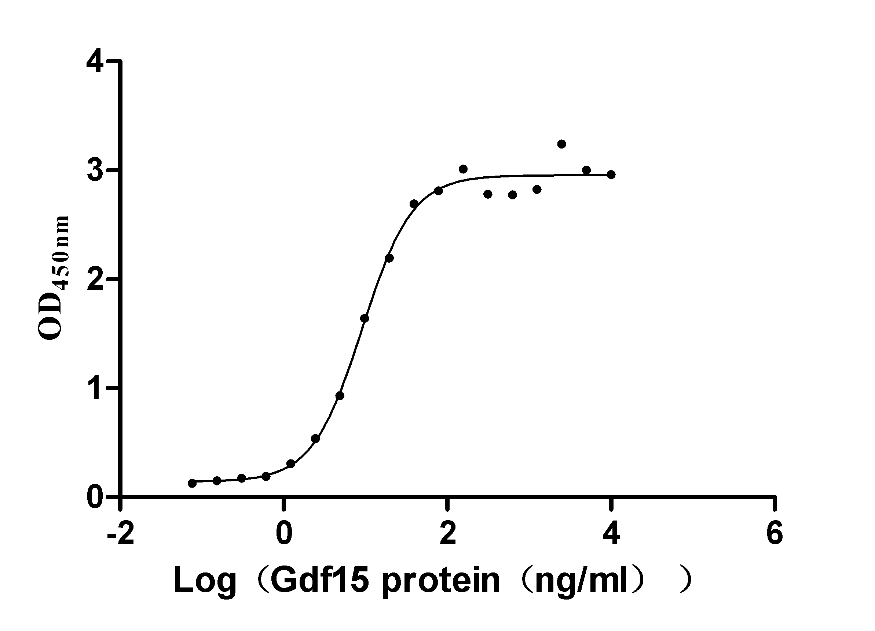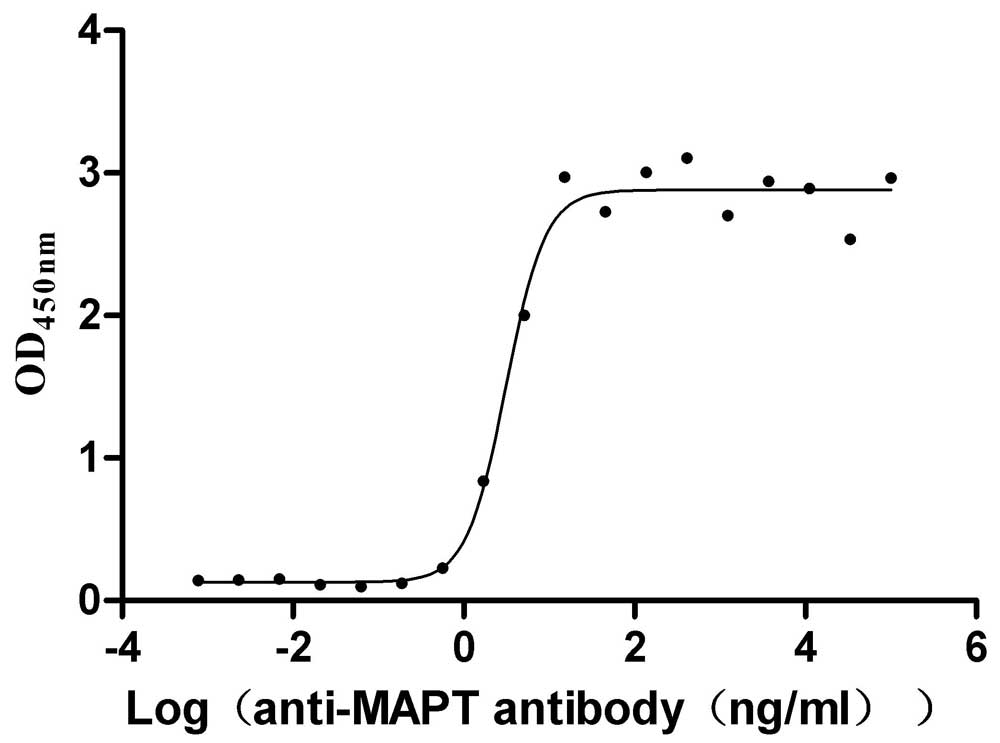Recombinant Saccharomyces cerevisiae DNA-directed RNA polymerase II subunit RPB4 (RPB4)
-
货号:CSB-YP018331SVG
-
规格:
-
来源:Yeast
-
其他:
-
货号:CSB-EP018331SVG
-
规格:
-
来源:E.coli
-
其他:
-
货号:CSB-EP018331SVG-B
-
规格:
-
来源:E.coli
-
共轭:Avi-tag Biotinylated
E. coli biotin ligase (BirA) is highly specific in covalently attaching biotin to the 15 amino acid AviTag peptide. This recombinant protein was biotinylated in vivo by AviTag-BirA technology, which method is BriA catalyzes amide linkage between the biotin and the specific lysine of the AviTag.
-
其他:
-
货号:CSB-BP018331SVG
-
规格:
-
来源:Baculovirus
-
其他:
-
货号:CSB-MP018331SVG
-
规格:
-
来源:Mammalian cell
-
其他:
产品详情
-
纯度:>85% (SDS-PAGE)
-
基因名:RPB4
-
Uniprot No.:
-
别名:RPB4; YJL140W; J0654; DNA-directed RNA polymerase II subunit RPB4; RNA polymerase II subunit B4; B32; DNA-directed RNA polymerase II 32 kDa polypeptide
-
种属:Saccharomyces cerevisiae (strain ATCC 204508 / S288c) (Baker's yeast)
-
蛋白长度:full length protein
-
表达区域:1-221
-
氨基酸序列MNVSTSTFQT RRRRLKKVEE EENAATLQLG QEFQLKQINH QGEEEELIAL NLSEARLVIK EALVERRRAF KRSQKKHKKK HLKHENANDE TTAVEDEDDD LDEDDVNADD DDFMHSETRE KELESIDVLL EQTTGGNNKD LKNTMQYLTN FSRFRDQETV GAVIQLLKST GLHPFEVAQL GSLACDTADE AKTLIPSLNN KISDDELERI LKELSNLETL Y
-
蛋白标签:Tag type will be determined during the manufacturing process.
The tag type will be determined during production process. If you have specified tag type, please tell us and we will develop the specified tag preferentially. -
产品提供形式:Lyophilized powder
Note: We will preferentially ship the format that we have in stock, however, if you have any special requirement for the format, please remark your requirement when placing the order, we will prepare according to your demand. -
复溶:We recommend that this vial be briefly centrifuged prior to opening to bring the contents to the bottom. Please reconstitute protein in deionized sterile water to a concentration of 0.1-1.0 mg/mL.We recommend to add 5-50% of glycerol (final concentration) and aliquot for long-term storage at -20℃/-80℃. Our default final concentration of glycerol is 50%. Customers could use it as reference.
-
储存条件:Store at -20°C/-80°C upon receipt, aliquoting is necessary for mutiple use. Avoid repeated freeze-thaw cycles.
-
保质期:The shelf life is related to many factors, storage state, buffer ingredients, storage temperature and the stability of the protein itself.
Generally, the shelf life of liquid form is 6 months at -20°C/-80°C. The shelf life of lyophilized form is 12 months at -20°C/-80°C. -
货期:Delivery time may differ from different purchasing way or location, please kindly consult your local distributors for specific delivery time.Note: All of our proteins are default shipped with normal blue ice packs, if you request to ship with dry ice, please communicate with us in advance and extra fees will be charged.
-
注意事项:Repeated freezing and thawing is not recommended. Store working aliquots at 4°C for up to one week.
-
Datasheet :Please contact us to get it.
靶点详情
-
功能:DNA-dependent RNA polymerase catalyzes the transcription of DNA into RNA using the four ribonucleoside triphosphates as substrates. Component of RNA polymerase II which synthesizes mRNA precursors and many functional non-coding RNAs. Pol II is the central component of the basal RNA polymerase II transcription machinery. It is composed of mobile elements that move relative to each other. RPB4 is part of a subcomplex with RPB7 that binds to a pocket formed by RPB1, RPB2 and RPB6 at the base of the clamp element. The RBP4-RPB7 subcomplex seems to lock the clamp via RPB7 in the closed conformation thus preventing double-stranded DNA to enter the active site cleft. The RPB4-RPB7 subcomplex binds single-stranded DNA and RNA. The RPB4-RPB7 subcomplex is necessary for promoter-directed transcription initiation but is not required for recruitment of Pol II to active preinitiation complexes and seems to be dispensable for transcription elongation and termination. The RPB4-RPB7 subcomplex recruits FCP1 to Pol II. Involved in DNA repair of damage in the transcribed strand. RPB4 is dispensable under optimal growth conditions, but becomes essential during heat or cold shock and under nutrient depletion. Suppresses the RBP9-mediated transcription-coupled repair (TCR) subpathway of nucleotide excision repair (NER) but facilitates the RAD26-mediated TCR subpathway. Under stress conditions only, involved in mRNA export to the cytoplasm. Involved in mRNA decay. Promotes or enhances the deadenylation process of specific mRNAs and may recruit PAT1 and the LSM1-7 complex to these mRNAs, thus stimulating their decapping and further decay.
-
基因功能参考文献:
- Our data indicate that the environmental stress response that occurs in foot mutants depends mostly on a global post-transcriptional regulation mechanism which, in turn, depends on Rpb4-mRNA imprinting PMID: 27001033
- Rpb4 is a bona fide Pol II core subunit that functions mainly in mRNA synthesis. PMID: 24802753
- Rpb4 is required for elongation, in gene specific manner under certain conditions.Rpb4 assists Paf1 in elongation of FKS1 gene under cellular stress condition. PMID: 24780862
- Subunit of RNA polymerase II, Rpb4p, is required for the decay of a class of mRNAs whose products are involved in protein synthesis. PMID: 16357218
- Loss of Rpb4 reduces RNA polymerase II levels near 3' ends of multiple mRNA genes, decreases association of 3'-end processing factors, & alters polyadenylation site usage at the RNA14 gene. Rpb4 contributes to cotranscriptional 3'-end processing in vivo. PMID: 18195044
- This report provides the first instance of a distinct role for Rpb4 in transcription, which is independent of its interacting partner, Rpb7. PMID: 18441121
- Rpb4 is involved in the expression of genes downstream of the RAM pathway. PMID: 18687406
显示更多
收起更多
-
亚细胞定位:Nucleus. Cytoplasm. Cytoplasm, P-body. Note=Seems to shuttle between nucleus and cytoplasm in a complex with RPB7.
-
蛋白家族:Eukaryotic RPB4 RNA polymerase subunit family
-
数据库链接:
KEGG: sce:YJL140W
STRING: 4932.YJL140W
Most popular with customers
-
Recombinant Mouse GDNF family receptor alpha-like (Gfral), partial (Active)
Express system: Mammalian cell
Species: Mus musculus (Mouse)
-
Recombinant Human Nectin-4 (NECTIN4), partial (Active)
Express system: Mammalian cell
Species: Homo sapiens (Human)
-
Recombinant Macaca mulatta Microtubule-associated protein tau (MAPT) (Active)
Express system: Mammalian cell
Species: Macaca mulatta (Rhesus macaque)
-
Recombinant Human Cannabinoid receptor 1 (CNR1)-VLPs (Active)
Express system: Mammalian cell
Species: Homo sapiens (Human)
-
Recombinant Human Desmoglein-3 (DSG3), partial (Active)
Express system: Baculovirus
Species: Homo sapiens (Human)
-
Recombinant Mouse Gastric inhibitory polypeptide receptor (Gipr), partial (Active)
Express system: Mammalian cell
Species: Mus musculus (Mouse)
-
Recombinant Human Interleukin-2 (IL2) (Active)
Express system: Mammalian cell
Species: Homo sapiens (Human)
-
Recombinant Macaca fascicularis C-type lectin domain family 4 member C(CLEC4C), partial (Active)
Express system: Mammalian cell
Species: Macaca fascicularis (Crab-eating macaque) (Cynomolgus monkey)




















